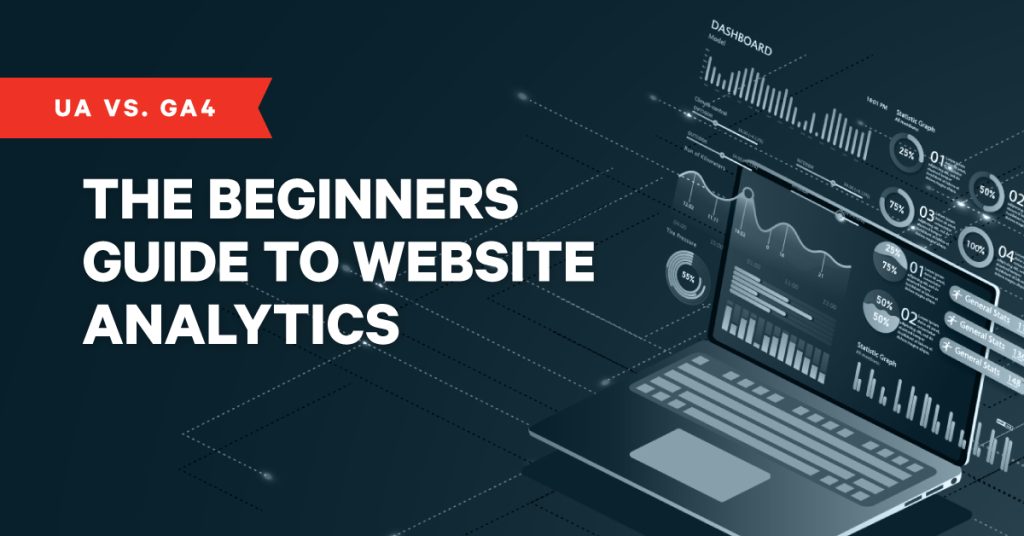UA vs. GA4: The Beginners Guide to Website Analytics

We’re here to help you understand the why behind website analytics, and clue you in about the upcoming switch from Universal Analytics to Google Analytics 4.
If you were confused and/or bamboozled by the words above, don’t worry — you’re in the right place. The wide world of web analytics can be a scary place, but The Abbi Agency is here to help guide you through these treacherous waters!
Some important background lore for any web analytics beginner: Google Analytics is one of the most popular website analytics services, used by a vast amount of people to find insights into how their websites are performing. In 2012, Google Analytics released a version of this platform called Universal Analytics (UA), which revolutionized the practice of collecting and organizing user data by using a model based on sessions and pageviews (we’ll explain what that means later). In 2020, Google released the newest version of their analytics platform: Google Analytics 4 (GA4). Starting in July 2023, GA4 will become the default version of Google Analytics, doing away with the program’s previous iteration. Au revoir and bon voyage to the depths of obsolescence, UA!
In this blog, we’ll be going over everything you could ever need to know about the basics of web analytics and why they matter, and also why Google is making the switch from UA to GA4. For more delicious tidbits of knowledge, head on over to the rest of our blog and see what’s cooking!
Web Analytics— What Are They Good For?
First, we’re going back to basics. So, why the heck do we even use web analytics? That dashboard just looks like a bunch of numbers and graphs! Like most worthwhile endeavors, understanding the impact of web analytics comes down to reading between the lines, and weaving together the story these numbers and graphs tell about your website and the people visiting it.
The chosen method of collecting web analytics is fairly customizable — you can select which tool you use, which metrics you track, and how you build out reports. If you’re the one doing the tracking, don’t feel like you have to monitor every single metric available! Tracking too much information at once makes it almost impossible to both identify key issues and create actionable solutions, so don’t do that. Don’t you dare!
KEY USES FOR WEBSITE ANALYTICS
1. Identifying key audiences and demographics
Capturing the attention of the “ideal consumer” can sometimes feel like the white whale of marketing, but website analytics make it easier than ever to identify who is visiting your website, and why they may have found themselves there. Analytics tools like Google Analytics track a variety of demographics when someone is on your site — including age, gender, geographic location, and more! They also let you see which devices and browsers visitors are using, allowing you to optimize user experience for those specific platforms and audiences.
2. Understanding how visitors interact with your website
Using web analytics is absolutely essential for tracking how visitors are interacting with your website — which pages are they lingering on? Which ones are they leaving from? Which are the most frequently visited? Tracking metrics like bounce rate, average time on individual pages, etc. is key to keeping up with your audience and continually improving the experience on your site.
3. Optimizing content and SEO
Web analytics also happen to be critical in shaping a business or brand’s content and SEO strategy — who would’ve thought? They can help you answer those pesky questions like “what are my site’s top-performing posts?” or “which topic clusters are resonating with my audience?” You can use this to do fun things, like adding CTA buttons to boost conversions on well-performing posts, or focusing your content more narrowly on the themes that are performing best.
So, analytics – what are they good for? Absolutely everything! Now that we have a basic understanding of web analytics under our belt, let’s dive into some of the more technical aspects of Google’s switch from Universal Analytics (UA) to Google Analytics 4 (GA4).
What is UA, and Why is it Going Away?
As previously mentioned, UA stands for “Universal Analytics,” and is the third version of the Google Analytics platform. Since its release more than 10 years ago, UA has provided insights for millions of websites across the globe, cementing its place as the gold standard for web tracking and analytics. Google has made updates and improvements to Google Analytics throughout the years, of course, but the next iteration of Google Analytics symbolizes a huge step into the modern digital landscape.
We’ll get into the nitty gritty of UA vs. GA4 in the next section, but TLDR;? UA wasn’t designed with our modern technological needs in mind, for obvious reasons. The digital world of 2012 couldn’t be more different from that of 2022, and websites now need to keep things like mobile accessibility, machine learning, and new legislation concerning data collection at top of mind. Come July 1, 2023 Google will sunset UA, but there are always new possibilities waiting on the horizon.
What is GA4? And What are the Main Differences Between UA vs. GA4?
Google Analytics 4 is, as you may have guessed, the fourth iteration of Google Analytics. A key difference between GA4 and UA is how they measure data; while UA leans toward desktop web, independent sessions, and using cookies for tracking data, GA4 represents a more modern solution, working across all platforms (desktop, mobile, and tablet), not relying on cookies, and using an events-based measurement model.
So, what the heck does that all mean? Stay with us — this is where it gets good! Let’s break down some of the key differences between UA vs. GA4:
Cross-Platform Tracking
In 2016 mobile web browsing overtook desktop for the first time, and the world has never looked back. UA, launched in 2012, simply wasn’t built to handle complicated interactions between devices like phones, desktops, and tablets. Mobile-focused design was still in its infancy — for some perspective, 2012 was the year Apple released the iPhone 5.
GA4 was created with today’s mobile-first mentality in mind, because we now know that the user’s journey isn’t limited to one platform or device. GA4 has the ability to use a single set of metrics for web and app data, so, for instance, if a user began their on their phone, then switched to desktop/tablet, then went back on their phone to complete the conversion, GA4 can track that! This ability mainly comes down to a new events-based measurement model, which we’ll talk about a little later.
Predictive AI Analytics
A fascinating new feature of GA4 is its ability to support predictive metrics using machine-learning algorithms. Yes, Google tells the future now! GA4 enriches data using these predictive metrics in order to predict the future behavior of users, which is only slightly terrifying. This tool can be used to identify users and their actions on a website that will likely lead to a conversion.
Increased Data Security
In today’s world, data has more power than ever. The so-called “data economy” of the digital world has grown exponentially in recent years, with businesses and individuals collecting and compiling a huge amount of information about where people are congregating on the web, and why. But, of course, with great power comes great responsibility. UA was designed in a period in which cookies were king, and the complications of data privacy were only beginning to reveal themselves.
By contrast, data privacy is built into the very foundations of GA4. New features include the automatic anonymization of IP addresses, as well as the new admin ability to delete data for any user at their request. GA4 also makes it easier than ever to comply with new data privacy and protection laws by letting you customize the user data you collect, without compromising any of your site’s key functionalities.
An Updated Measurement Model
Contrary to its name, an “event-based measurement model” doesn’t mean Google uses weddings, birthday parties, and business conferences to measure your web data. Event tracking allows Google to record specific user interactions on a website or app, and has actually been around since 2007. “Events” refer to these specific interactions, which can include everything from hitting play on a video to clicking on a CTA banner.
UA collects data based on sessions — the period of time a user is active on your site/app. The program records a user coming to your site and starting a session, and then records the actions this user has taken as “hits.” Actions that aren’t included as “hits” can be created manually as “events.” These can include video views, file downloads, widget clicks, etc., but they are not tracked by default.
If you’re like, “that sounds complicated!”, you’d be right! By comparison, GA4 comes with a fully furnished suite of pre-made actions and events, making it easy to track metrics that previously required manual setup.
GA4: Showing the Data-Backed Power of PR
Beyond analytics being used in expected agency departments like web and paid media, GA4 brings true data-backed results for those on a public relations team. Because GA4 is much more granular; you can track the customer much better than before, most notably in the attribution models. By adjusting and tailoring attribution models, you can get a clearer understanding of the impact earned media has on your client’s goals. Yes, UA lets you view if a customer came to your site from a backlink in earned media. But now, GA4 allows you to view way more! Did they scroll all the way to the bottom of a webpage? Did they download a white paper, or sign up for your newsletter, or watch a whole video on your site? These are all things that can be traced back to a news piece you secured, making it easier than ever to show the power of public relations to your clients!
So… What Happens Now?
As you may have guessed, here at TAA we use Google Analytics to track and understand user engagement with client websites, and we like to think we do a pretty bang up job. The new GA4 platform will help us delve even deeper into the stories told by our user data, and we’re looking forward to the switch.
We know change can be scary, and seeing an unfamiliar set of data on a dashboard teeming with information can be overwhelming, to put it mildly. If you see slightly different numbers compared to old traffic data, don’t panic! Small discrepancies will be normal, and should be noted but not concerned about.
At The Abbi Agency, we enjoy nothing more than increasing ROI with data-driven marketing insights and strategies. And when it comes to staying ahead of the curve? Well, we already know that after that curve comes another, and another — an endless rollercoaster of progress and innovation. Being the marketing thrill seekers we are, TAA loves being a few loops ahead. Our team is already on their way to mastering GA4 well before the July 1, 2023 deadline, so our clients will have a seamless integration between old analytics and new.
So really, we couldn’t be more excited about the switch from UA to GA4 — we hope you are too, whether you’re a fellow marketer, a current client, or a prospective one.



